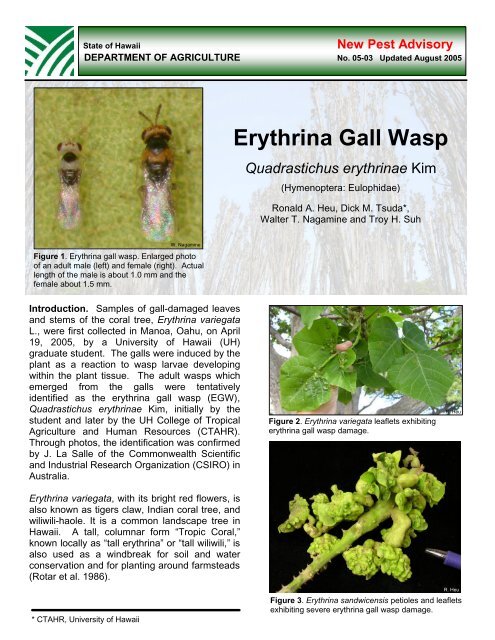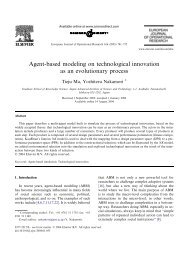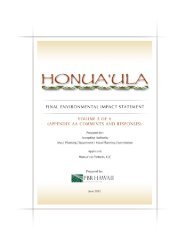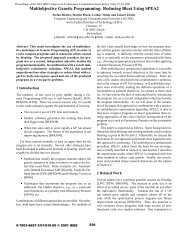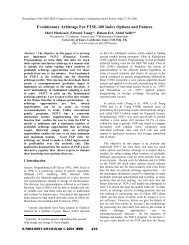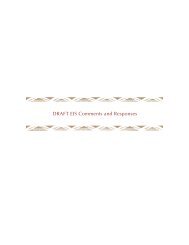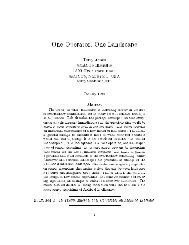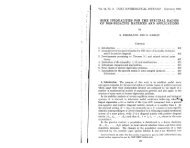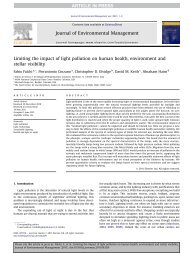NPA Erythrina Gall Wasp MASTER
NPA Erythrina Gall Wasp MASTER
NPA Erythrina Gall Wasp MASTER
- No tags were found...
You also want an ePaper? Increase the reach of your titles
YUMPU automatically turns print PDFs into web optimized ePapers that Google loves.
State of Hawaii<br />
New Pest Advisory<br />
DEPARTMENT OF AGRICULTURE No. 05-03 Updated August 2005<br />
<strong>Erythrina</strong> <strong>Gall</strong> <strong>Wasp</strong><br />
Quadrastichus erythrinae Kim<br />
(Hymenoptera: Eulophidae)<br />
Ronald A. Heu, Dick M. Tsuda*,<br />
Walter T. Nagamine and Troy H. Suh<br />
W. Nagamine<br />
Figure 1. <strong>Erythrina</strong> gall wasp. Enlarged photo<br />
of an adult male (left) and female (right). Actual<br />
length of the male is about 1.0 mm and the<br />
female about 1.5 mm.<br />
Introduction. Samples of gall-damaged leaves<br />
and stems of the coral tree, <strong>Erythrina</strong> variegata<br />
L., were first collected in Manoa, Oahu, on April<br />
19, 2005, by a University of Hawaii (UH)<br />
graduate student. The galls were induced by the<br />
plant as a reaction to wasp larvae developing<br />
within the plant tissue. The adult wasps which<br />
emerged from the galls were tentatively<br />
identified as the erythrina gall wasp (EGW),<br />
Quadrastichus erythrinae Kim, initially by the<br />
student and later by the UH College of Tropical<br />
Agriculture and Human Resources (CTAHR).<br />
Through photos, the identification was confirmed<br />
by J. La Salle of the Commonwealth Scientific<br />
and Industrial Research Organization (CSIRO) in<br />
Australia.<br />
<strong>Erythrina</strong> variegata, with its bright red flowers, is<br />
also known as tigers claw, Indian coral tree, and<br />
wiliwili-haole. It is a common landscape tree in<br />
Hawaii. A tall, columnar form “Tropic Coral,”<br />
known locally as “tall erythrina” or “tall wiliwili,” is<br />
also used as a windbreak for soil and water<br />
conservation and for planting around farmsteads<br />
(Rotar et al. 1986).<br />
Figure 2. <strong>Erythrina</strong> variegata leaflets exhibiting<br />
erythrina gall wasp damage.<br />
R. Heu<br />
* CTAHR, University of Hawaii<br />
R. Heu<br />
Figure 3. <strong>Erythrina</strong> sandwicensis petioles and leaflets<br />
exhibiting severe erythrina gall wasp damage.
Distribution and Hosts. The erythrina gall<br />
wasp was recently described as a new species<br />
by Kim et. al (2004) from specimens from<br />
Singapore, Mauritius, and Reunion. It was<br />
recently found damaging coral trees in Taiwan<br />
(Yang et al. 2004). In the State, gall wasp<br />
damage has been found throughout the island of<br />
Oahu. On July 21, 2005, gall wasp damage was<br />
reported from Kona on the Big Island (D. Oishi,<br />
pers. comm.). On July 26, it was found at Lihue<br />
Airport on Kauai (C. Kaneshige and E. Garcia,<br />
pers. comm.). Several days later, on July 30,<br />
2005, it was reported in the Kahului area of Maui<br />
(M. Fukada, pers. comm.). In Hawaii, the coral<br />
trees, <strong>Erythrina</strong> variegata L. (including “tall<br />
erythrina”), E. crista-galli L., and the native E.<br />
sandwicensis Degener have been affected.<br />
H.-C. Kuo<br />
T. Suh<br />
Figure 4 (left). <strong>Erythrina</strong> gall<br />
wasp pupa dissected from<br />
gall.<br />
Figure 5 (above). Exit<br />
holes created by adult<br />
erythrina gall wasps.<br />
R. Heu<br />
Figure 6 (left). Severe<br />
damage to “tall erythrina”<br />
by the erythrina gall wasp.<br />
Damage. Like other gall-forming eulophid wasps,<br />
eggs are inserted into young leaf and stem tissue.<br />
The wasp larvae, which develop within plant tissue,<br />
induce the formation of galls in leaflets and petioles<br />
(Figure 2). As the infestation progresses, leaves curl<br />
and appear deformed while petioles and shoots<br />
become swollen (Figure 3). After feeding is<br />
complete, larvae pupate within the leaf and stem<br />
tissue (Figure 4). After pupation within the galls,<br />
adult wasps emerge after cutting exit holes through<br />
to the outside (Figure 5). Heavily galled leaves and<br />
stems result in a loss of growth and vigor. According<br />
to Yang et al. (2004), severe infestations can cause<br />
defoliation and death of trees (Figure 6).<br />
Management. In Taiwan, other parasitic<br />
wasps, including species in the families<br />
Encyrtidae, Eupelmidae, and Pteromalidae,<br />
were reared from (erythrina) twigs with galls<br />
(Yang et al. 2004). At least one may be a native<br />
parasitoid which is exploiting the gall wasp as a<br />
host. In South Africa, a complex of parasitic<br />
wasps, including a species of Quadristichus, is<br />
also associated with galls on <strong>Erythrina</strong> (G.<br />
Prinsloo and M. Wright, pers. comm.). On<br />
Oahu, samples of galled erythrina have not<br />
produced any local parasitoids of the gall wasp.<br />
The use of systemic insecticides is being<br />
investigated (A. Hara, G. Hera, and J. Harada,<br />
pers. comm.).<br />
Acknowledgement. We gratefully acknowledge<br />
H.-C. Kuo for collecting the first samples of this<br />
new plant pest and providing them to CTAHR.<br />
Thanks also to N. Reimer, D. Oishi, M.<br />
Ramadan, J. Yalemar, B. Azama, D. Arakaki, C.<br />
Okumoto, E. Garcia, C. Kaneshige, and M.<br />
Fukada for information on new EGW infestation<br />
sites. HDOA surveys were supported and<br />
funded in part by the USDA, APHIS,<br />
Cooperative Agricultural Pest Survey (CAPS)<br />
Program.<br />
References<br />
Rotar, P.P., R.J. Joy, and P.R. Weissich. 1986.<br />
“Tropic Coral” tall erythrina. Univ. Haw.<br />
CTAHR Res. Ext. Ser. 072.<br />
Yang, M.M., G.S. Tung, J. La Salle, and M.L.<br />
Wu. 2004. Outbreak of erythrina gall<br />
wasp on <strong>Erythrina</strong> spp. (Fabaceae) in<br />
Taiwan. Plant Prot. Bull. 46:391-396.<br />
Kim, I.-K., G. Delvare, and J. La Salle. 2004. A<br />
new species of Quadrastichus<br />
(Hymenoptera: Eulophidae): A gallinducing<br />
pest on <strong>Erythrina</strong> spp.<br />
(Fabaceae). J. Hym. Res. 13(2): 243-<br />
249.<br />
PLANT PEST CONTROL BRANCH, Division of Plant Industry, Hawaii Department of Agriculture First issued May 27, 2005<br />
1428 South King Street, Honolulu, Hawaii 96814. Phone (808) 973-9530. FAX (808 973-9533) Last updated August 3, 2005<br />
Web address: http://www.hawaiiag.org/hdoa/npa/npa05-03-EGW.pdf


